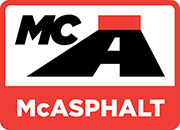Bond Tack Coats
In order to improve the bond between layers of pavement, a tack coat should be applied. A tack coat is very inexpensive insurance to improve the structural integrity of the pavement layer. There are many different types of tack coats and emulsions.
A bond coat is a spray application of asphalt emulsion. It is applied to an existing asphalt or portland cement concrete surface prior to a new asphalt overlay or patching. This eliminates slippage planes and provides a better bond between new and existing pavement layers.
Design Criteria
In order to design a proper tack coat the existing surface should be evaluated and repairs made prior to application. The existing road surface should be clean and dust free to ensure proper bond of tack coat to the existing surface. If the emulsion is to be diluted the dilution rate should be established so that the proper residual asphalt will be applied. The water for dilution should be clean, potable and free of detectable contaminants.
As a fog seal the Clean Bond Coat can be applied to an existing old asphalt surface or to a new or old seal coat. Because of its quick cure and non-tracking properties, conventional sand blotting is often not required.
Clean Bond Coat is ideal for spraying on low volume, unpaved roads as a means of dust control. This emulsion is usually diluted with water to further decrease its viscosity to enhance its penetration into the existing surface.
Materials
Asphalt Emulsions:
The clean bond coat is a slow setting anionic asphalt emulsion specifically designed to be very stable and allow for a shorter return to traffic and overlay. The tack coat cures very quickly and provides a non-tracking, non-tacky finish. Clean Bond Coat can be used for a number of applications such as tack coats, fog seals and dust control.
Performance Guidelines
In order to construct a proper well designed tack coat the following guidelines should be followed:
- Evaluate pavement to be tacked
- Determine desired spray rate
- Ensure tacking surface is clean and dust free
- Ensure compatibility of dilution water and emulsion
- Ensure using a proper distributer
- Calibrate and inspect all equipment
- Follow proper construction techniques
- Allow tack to break and set before overlay placed
- Work only in weather suitable for type and grade of emulsion being used
Safety Data Sheets
| Description | Pdf File |
|---|---|
| SDS – Anionic Rapid Setting Emulsion | |
| SDS – Anionic Slow Setting Emulsion | |
| SDS – Cationic Medium Setting Emulsion | |
| SDS – Enviro-Colle Emulsion | |
| SDS – Rapid Curing Cutback |
